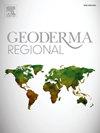chernozem发生在波兰吗?波兰黄土带黑土的分布、性质及区域差异
IF 3.3
2区 农林科学
Q2 SOIL SCIENCE
引用次数: 0
摘要
虽然黑钙土自19世纪后期就出现在波兰的土壤地图上,但它们在波兰的出现在全球和区域土壤地图以及外国作者的报告中都被省略了。本文旨在验证波兰南部黄土带5个“黑钙化”地区符合世界土壤资源参考基地(WRB)定义的黑钙化标准的土壤的出现、丰度和性质。该分析发现,在5个“黑钙化”区中,有4个区所研究的土壤剖面中有15 - 55%存在黑钙土,而所有地区的主要伴生土壤都是黑钙土。大多数菲厄赞斯都有专业的视野;因此,将其划分为黑钙岩或辉绿岩的关键特征是次生碳酸盐的存在和深度。在中南部和东部地区普遍存在的灰壤和钙质黑钙土的空间变化受侵蚀影响较大,而粘土光照在土壤剖面中表现相对较差。山前地区的土壤广泛浸出了碳酸盐,并且通常具有干旱层,这表明Luvic Phaeozems占主导地位。Gleyic/Stagnic Luvic Chernozems/Phaeozems在最西部地区盛行,其特点是平原地形和不完善的排水系统。波兰黑钙土和非黑钙土的表层土壤pH值、土壤有机碳和粘土含量从最东部地区向西部和南部下降,在那里,湿润的“海洋影响”或“山地影响”分别被认为是全新世期间更强烈的土壤淋溶的原因。波兰南部黄土发育的Chernozems和Phaeozems的土壤有机碳(区域平均值在1.7 - 2.8%之间)、粘土(11 - 21%)和pH(6.4-7.4)值低于俄罗斯南部、乌克兰和摩尔多瓦草原带的Chernozems,但与邻近的中欧国家(乌克兰西北部、斯洛伐克、捷克和德国)的报告值相当。在所有被研究的地区都发现了chernic层,这证实了(a)黑钙土和phaeozem具有地下的多成因,(b)再生或保守农业在对抗侵蚀和恢复富含腐殖质和生物活性的表土层方面的巨大潜力,这可以保护波兰南部的黑钙土和phaeozem免受进一步腐烂。本文章由计算机程序翻译,如有差异,请以英文原文为准。
Do Chernozems occur in Poland? Distribution, properties and regional variation of black soils in the loess belt of Poland
Although Chernozems have appeared on Polish soil maps since the late 19th century, their occurrence in Poland is omitted from global and regional soil maps and the reports of foreign authors. This paper aims to verify the occurrence, abundance and properties of soils that meet the criteria for Chernozems as defined by the World Reference Base for Soil Resources (WRB) in five ‘chernozemic’ regions in the loess belt of southern Poland. This analysis identified Chernozems in 15–55 % of the studied soil profiles in four of the five ‘chernozemic’ regions, while the major accompanying soils in all regions were Phaeozems. Most Phaeozems have chernic horizons; therefore, the crucial characteristics allowing classification as a Chernozem or Phaeozem were the presence and depth of secondary carbonates. The spatial variation of Haplic and Calcic Chernozems, which prevail in the (south) central and eastern regions, was strongly affected by erosion, while clay illuviation was relatively poorly indicated in soil profiles. Soils in the fore-mountain regions were extensively leached of carbonates and often had argic horizons, which implies a predominance of Luvic Phaeozems. Gleyic/Stagnic Luvic Chernozems/Phaeozems prevailed in the westernmost region, which is characterised by plain topography and imperfect water drainage. The topsoil pH, soil organic carbon and clay contents of Polish Chernozems and Phaeozems decreased from the easternmost region towards the west and south, where the humid ‘oceanic influences’ or ‘mountain influences’, respectively, are considered responsible for more intense soil leaching during the Holocene period. The soil organic carbon (regional mean values in a range of 1.7–2.8 %), clay (11–21 %) and pH (6.4–7.4) values in Chernozems and Phaeozems developed from loess in southern Poland are lower compared to Chernozems of the steppe zone of southern Russia, Ukraine and Moldova, but comparable with their values reported from neighbouring Central European countries (northwestern Ukraine, Slovakia, Czechia and Germany). The presence of chernic horizons in all studied regions affirms (a) the polygenetic origin of Chernozems and Phaeozems with subsurface argic horizons, and (b) the large potential of regenerative or conservative agriculture in combating erosion and restoring humus-rich and biologically active topsoil layers, which can preserve Chernozems and Phaeozems against further decay in southern Poland.
求助全文
通过发布文献求助,成功后即可免费获取论文全文。
去求助
来源期刊

Geoderma Regional
Agricultural and Biological Sciences-Soil Science
CiteScore
6.10
自引率
7.30%
发文量
122
审稿时长
76 days
期刊介绍:
Global issues require studies and solutions on national and regional levels. Geoderma Regional focuses on studies that increase understanding and advance our scientific knowledge of soils in all regions of the world. The journal embraces every aspect of soil science and welcomes reviews of regional progress.
 求助内容:
求助内容: 应助结果提醒方式:
应助结果提醒方式:


